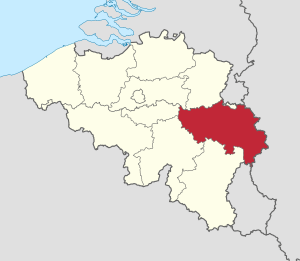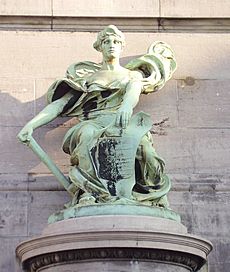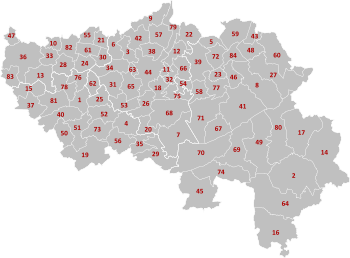Liège Province facts for kids
Quick facts for kids
Liège (French)
|
|||
|---|---|---|---|
|
|||
 |
|||
| Country | |||
| Region | |||
| Capital (and largest city) |
Liège | ||
| Area | |||
| • Total | 3,857 km2 (1,489 sq mi) | ||
| Population
(1 January 2019)
|
|||
| • Total | 1,106,992 | ||
| • Density | 287.01/km2 (743.35/sq mi) | ||
| HDI (2019) | 0.903 very high · 8th of 11 |
||
Liège (pronounced "lee-ezh") is the easternmost province in the Wallonia region of Belgium. It's a special place because it's the only Belgian province that shares borders with three different countries!
To the north, it touches the Dutch province of Limburg. To the east, it borders the German states of North Rhine-Westphalia and Rhineland-Palatinate. To the southeast, it meets the Luxembourgish area of Clervaux. Liège also borders several other Belgian provinces. These include Luxembourg, Namur, and Walloon Brabant (which are French-speaking). It also borders Flemish Brabant and Limburg (which are Dutch-speaking).
A small part of eastern Liège, near Germany, is a German-speaking region. This area, called Eupen-Malmedy, became part of Belgium after World War I.
The main city and capital of the province is also called Liège. The province covers an area of about 3,857 square kilometers (1,489 square miles). As of January 2019, over 1.1 million people live there.
Contents
History of Liège Province
The borders of Liège Province we see today were set in 1795. This happened when the old Prince-Bishopric of Liège joined with a French area called the Ourthe department.
French Control and Napoleon
The province, then known as Ourthe, was under French control when Napoleon Bonaparte was in charge. Napoleon even visited the city of Liège. He ordered the destruction of its vineyards. This was to stop Liège's wine industry from competing with France's own wine production.
Becoming Part of the Netherlands
After Napoleon lost power in 1815, Liège became part of the Kingdom of the Netherlands. Scholars from Liège University helped write the new Dutch constitution. However, many people in Liège felt unfairly treated by the Dutch government. This was due to differences in religion and language.
The Belgian Revolution
In September 1830, rumors spread that the Dutch were being forced out of Brussels. People in Liège, especially thinkers and leaders, talked with others in Paris about Belgium becoming independent. A group of fighters was formed, which helped lead to the Belgian Revolution. This revolution created an independent Kingdom of Belgium.
Industrial Growth and World Wars
In the 1800s, Liège became a major center for the Industrial Revolution. It had lots of coal and steel factories. This helped Belgium become a strong economic power.
Because Liège borders Germany, it saw heavy fighting in both World Wars. In World War I, Liège's strong forts slowed down the German army. This gave time for trenches to be built in Flanders, where some of the war's worst battles took place. Sadly, many civilians in Liège also suffered during this time.
In 1925, the East Cantons and Neutral Moresnet became part of Liège province. These areas had been given to Belgium after the Treaty of Versailles.
In World War II, Liège was a key battleground during the Battle of the Bulge. This was Germany's last big attack against the Allied armies. Places like Malmedy and Saint-Vith saw very intense fighting. A terrible event known as the Malmedy massacre happened there, where Waffen-SS soldiers killed American prisoners of war.
Liège's heavy industries did very well in the 1950s and 1960s. However, they have been slowly declining since then. Today, Liège is the last city in Wallonia that still has a working steel industry.
Liège remains an important center for business and culture in Wallonia. It has a university, a rich medieval history, and its remaining industries.
Politics in Liège
Liège Province has a special council that helps run things. This is called the Provincial Council. It's made up of members from different political parties. They work together to make decisions for the province.
Provincial Council (2018–2024)

The table below shows how many seats each party has in the Provincial Council for the current term.
| Party | Seats |
|---|---|
| PS-SP | 17 |
| Mouvement réformateur | 15 |
| Ecolo | 12 |
| CDH-CSP | 6 |
| Parti du travail de Belgique | 6 |
Geography of Liège
Rivers
Several rivers flow through Liège Province, adding to its beautiful landscapes.
- Roannay
- Ourthe
- Berwinne
Economy
Liège Province is an important economic area in Belgium. In 2018, the total value of all goods and services produced in the province was 31.6 billion Euros. This shows how much the province contributes to Belgium's overall economy.
Subdivisions of Liège
The province covers an area of 3,857 square kilometers. It is divided into four main administrative areas called arrondissements (which is French for districts). These arrondissements contain a total of 84 smaller areas called municipalities.
Arrondissements
The four administrative districts of Liège Province are:
Municipalities

Here is a list of all the municipalities in Liège Province. If a municipality has (city) next to its name, it means it has official city status.
- Amay
- Amel
- Ans
- Anthisnes
- Aubel
- Awans
- Aywaille
- Baelen
- Bassenge
- Berloz
- Beyne-Heusay
- Blegny
- Braives
- Büllingen
- Burdinne
- Burg-Reuland
- Bütgenbach
- Chaudfontaine
- Clavier
- Comblain-au-Pont
- Crisnée
- Dalhem
- Dison
- Donceel
- Engis
- Esneux
- Eupen (city)
- Faimes
- Ferrières
- Fexhe-le-Haut-Clocher
- Flémalle
- Fléron
- Geer
- Grâce-Hollogne
- Hamoir
- Hannut (city)
- Héron
- Herstal
- Herve (city)
- Huy (city)
- Jalhay
- Juprelle
- Kelmis
- Liège (city)
- Lierneux
- Limbourg (city)
- Lincent
- Lontzen
- Malmedy (city)
- Marchin
- Modave
- Nandrin
- Neupré
- Olne
- Oreye
- Ouffet
- Oupeye
- Pepinster
- Plombières
- Raeren
- Remicourt
- Saint-Georges-sur-Meuse
- Saint-Nicolas
- Sankt Vith (city)
- Seraing (city)
- Soumagne
- Spa (city)
- Sprimont
- Stavelot (city)
- Stoumont
- Theux
- Thimister-Clermont
- Tinlot
- Trois-Ponts
- Trooz
- Verlaine
- Verviers (city)
- Villers-le-Bouillet
- Visé (city)
- Waimes
- Wanze
- Waremme (city)
- Wasseiges
- Welkenraedt
Nine of these municipalities are part of the German-speaking Community of Belgium. These are Kelmis, Lontzen, Raeren, Eupen, Bütgenbach, Büllingen, Amel, Sankt Vith, and Burg-Reuland. Malmedy and Waimes also have special rules for German speakers. All other municipalities in Liège are part of the French Community of Belgium.
List of Governors
The Governor is like the main leader of the province. The current Governor of Liège is Hervé Jamar.
See also
 In Spanish: Provincia de Lieja para niños
In Spanish: Provincia de Lieja para niños









